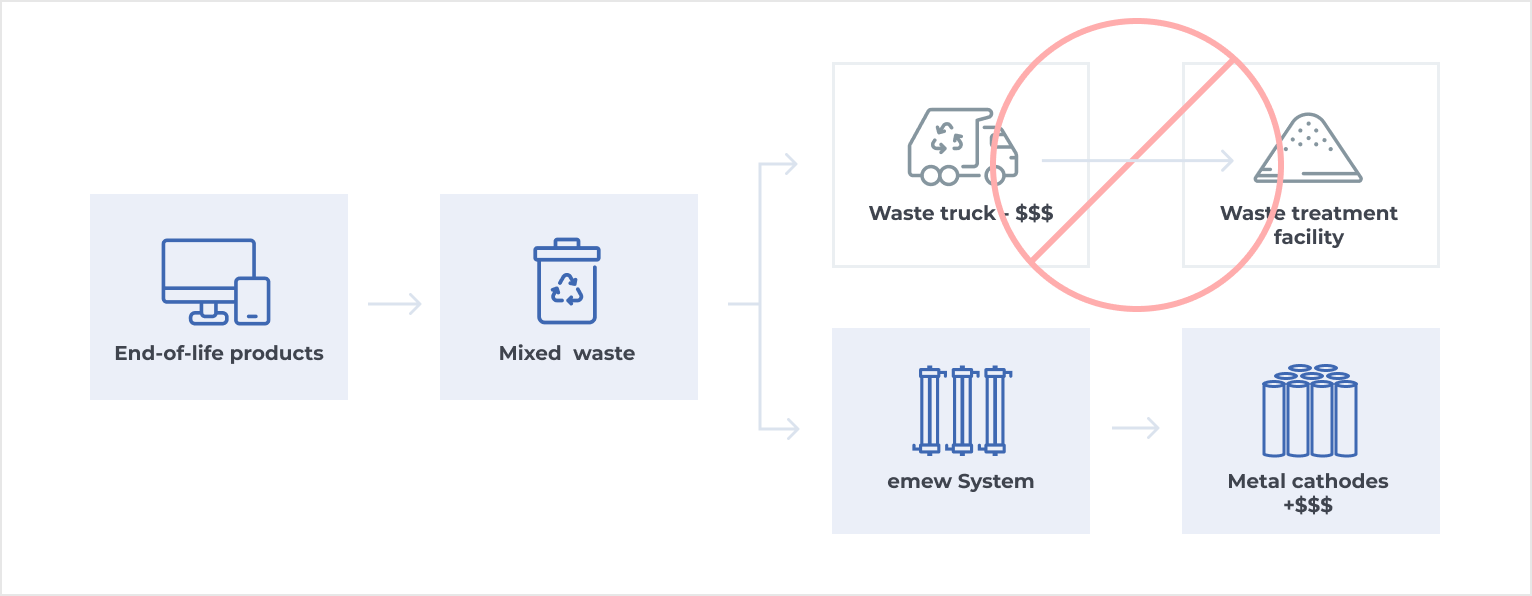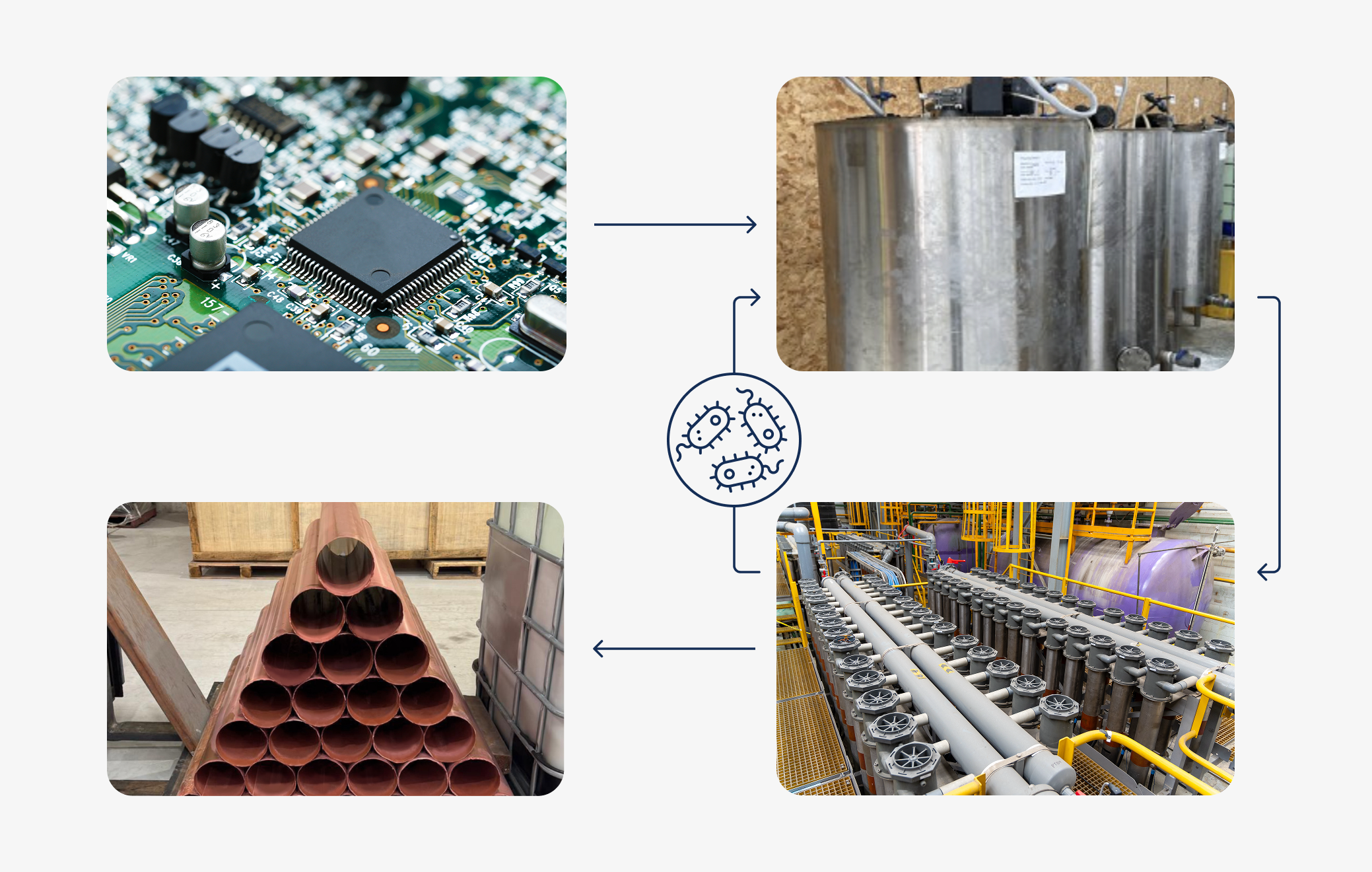Minimize your environmental impact
As technology advances, demand for metals continues to increase, causing economic, social, and environmental challenges in the supply chain. Existing mines may move out of operation as ores are depleted, lower-grade ores make processing and waste management more challenging, and stricter socio-environmental regulations may delay or hinder new operations from opening. Recycling has been highlighted by the United Nations (UN) as a key strategy for the success of the UN’s Sustainable Development Goals (SDGs). Recycling, defined as the reprocessing and repurposing of wastes, is essential because it closes the material flow loops to achieve a circular economy. (1)
The circular economy, in its simplest sense, is the concept of having no waste, by having everything be continuously reused and recycled – without losing any value. Of all the materials currently used globally, metals have the greatest potential for recycling, indefinitely. Metal and mineral resources have a finite supply, but with recycling their lifespan can become infinite. (2)
How does emew support the circular economy?
The emew system produces metals of very high purity, from low concentrations, with minimal to no metal waste. Valuable metals (such as copper, silver, and nickel) can be lost during the processes of metal refining, e-waste, and battery recycling. The emew system helps clients recover metals in these processes that would otherwise go to waste.

One example of how emew supports the circular economy is the use emew technology by a leading semiconductor manufacturer. During the rinse cycle of their semiconductors production, they collected the wastewater that had low concentrations of copper and recovered it using emew technology. By using emew, the copper was recovered and sold back to their copper supplier, completing the loop, and helping decrease their operating costs.
A key priority for emew is to offer technological solutions that can help customers meet their ESG goals. Using an emew plant to recover metals from wastewater can not only significantly minimize the scope 3 greenhouse gas (GHG) emissions of clients but can help meet regulatory requirements for environmental compliance.
By studying the environmental impact of emew in terms of global warming potential, emew has made changes to operations to minimize its carbon footprint - and better understand the impact of operational and design choices of an emew plant. In some cases, the inputs required to operate an emew plant can be recycled or reused from other processes (such as lime), minimizing the environmental footprint of the operation.
By using renewable electricity for the operation of a 90-cell copper plate emew plant, the global warming potential of electricity use can decrease by 98%, from 2,681 kg CO2e / tonne copper to 51 kg CO2e / tonne copper.

Source: emew Life Cycle Assessment, 2023, ecoinvent data. The electricity is from Australia for low-voltage electricity vs a 3kWp slanted-roof, single-Si, panel-mounted photovoltaic electricity production in Australia.
Ensuring wastes are properly treated is important to avoid any ecological or environmental damage. For example, high copper content in water or soil can inhibit the growth and reproduction of organisms and microorganisms. Copper (as Cu2+) will not naturally degrade in the environment and will bioaccumulate in the food chain. If there is excessive copper in the human body, there are severe health impacts. (3)
While emew wants to support clients in minimizing their environmental footprint, emew also understands the value of assessing its own impact; emew has a corporate greenhouse gas inventory to better understand the overall carbon footprint of the business. It became apparent that emew’s biggest impact can be made by minimizing scope 3 emissions – helping clients to meet their environmental goals and reduce their own carbon footprint.
Engaging with suppliers is another way that emew is working to minimize its footprint, by communicating its expectations and shared values when it comes to responsible sourcing and transportation of materials. Combining shipments and prioritizing the use of sea freight over air freight is a small example of how emew is working to decrease its carbon footprint. Per shipment, the difference between using sea freight vs air freight could be as much as 1840 kg CO2e, this is the same amount of CO2e emitted by burning 785 liters of gasoline or filling up your vehicle 13 times. (4) With hundreds of shipments a year, this small change amounts to a big impact - a 30% difference in emissions associated with freight alone.

The emew Group understands that tackling climate change is going to take collaboration and innovation from all sectors, and emew wants to be a part of the solution. Working to support the environmental goals of their clients, while also meeting their own environmental goals - emew is here to help provide low-carbon options for metal recovery.

Sources:
- https://www.sciencedirect.com/science/article/abs/pii/S0921344921002196
- https://www.sciencedirect.com/science/article/abs/pii/S0959652606002320
- https://www.sciencedirect.com/science/article/abs/pii/S0959652620353002
- https://www.epa.gov/greenvehicles/greenhouse-gas-emissions-typical-passenger-vehicle






